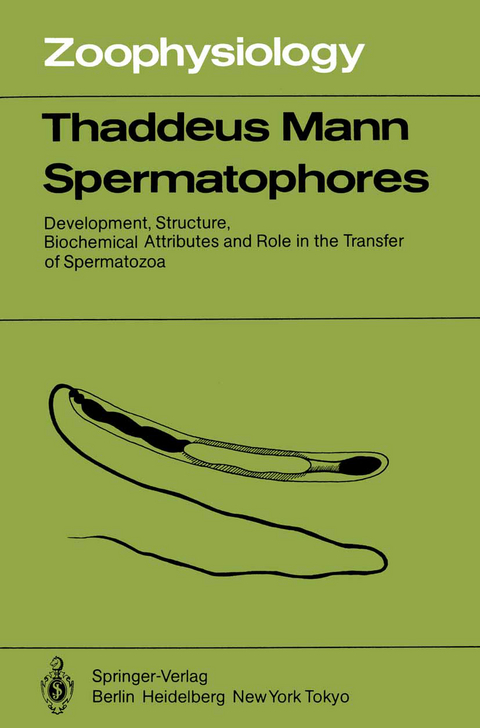
Spermatophores
Springer Berlin (Verlag)
978-3-642-82310-7 (ISBN)
1. General Considerations.- 1.1 Beginnings.- 1.2 Definitions.- 1.3 Spermatophore as Repository and Transport Vehicle for Spermatozoa. Certain Similarity to Epididymis.- 1.4 Direct and Indirect Insemination Routes.- 1.5 Role of Spermatophore in Fertilization and Nutrition.- 1.6 Common Features of Spermatophore, Copulatory Plug, and Sphragis.- 1.7 Conflicting Views on the Origin and Purpose of Spermatophores.- 2. Platyhelminthes, Aschelminthes, and Phoronida.- 2.1 Early Observations on the Attachment of Spermatophores to the Skin of Turbellaria.- 2.2 Mechanisms of Sperm Transfer in Turbellaria and Monogenea.- 2.3 Hypodermic Impregnation in Rotifera and Other Aschelminthes.- 2.4 Spermatophores of Phoronis vancouverensis and Phoronopsis harmeri, and the Role of Lophophoral Organs in Phoronida.- 3. Mollusca.- 3.1 Gastropoda: Prosobranchia, Opisthobranchia, and Pulmonata.- 3.2 Cephalopoda: Main Features of Male Reproductive Function in Nautiloidea, Decapoda, Vampyromorpha, and Octopoda.- 3.3 Nautiloidea: Nautilus pompilius and Nautilus macromphalus.- 3.4 Decapoda: Loligo pealii, Rossia macrosoma, Rossia pacifica, Sepiola rondeletii, and Sepia officinalis.- 3.5 Small Octopoda: Octopus vulgaris, Octopus hummelincki, Octopus bimaculatus, Other Small Octopuses, Eledone moschata, and Eledone cirrhosa.- 3.6 The Giant Octopus of the North Pacific, Octopus dofleini martini.- 3.7 Biochemistry of the Giant Octopus Spermatophore.- 4. Annelida.- 4.1 Polychaeta, Including Myzostomaria, and Archiannelida.- 4.2 Oligochaeta.- 4.3 Hirudinea.- 5. Onychophora and Myriapoda.- 5.1 Dermal Copulation and Spermatophores in Onychophora.- 5.2 Production of Spermatophores in Pauropoda.- 5.3 Direct and Indirect Transfer of Spermatozoa in Diplopoda.- 5.4 Peculiar Ring Structure of Spermatophores and Indirect Sperm Transfer in Chilopoda.- 5.5 External Fertilization in Symphyla.- 6. Insecta.- 6.1 Insemination Routes and Sperm-Encompassing Devices.- 6.2 Male Genital System.- 6.3 Relationships Between Sperm-Cysts, Sperm-Bundles, Spermatodesms, Spermatozeugmata, Droplet Spermatophores, and Typical Spermatophores.- 6.4 Role of Male Accessory Secretions in the Production of Spermatophores.- 6.5 Some Unusual Chemical Constituents of Male Accessory Secretions, and Their Passage into the Semen and Spermatophores: Indolalkyl Amine, Fructose, Glucose, and Trehalose, Pyrophosphate, Uric Acid, Cyclic Guanosine 3?,5?-Monophosphate, and Prostaglandin Synthetase.- 6.6 Gustatory and Aphrodisiac Attributes of Male Secretory Products and Spermatophores.- 6.7 Droplet Spermatophores in Apterygotan Insects: Collembola, Diplura, and Thysanura.- 6.8 Typical Spermatophores and Different Mechanisms of Their Assembly in Pterygotan Insects.- 6.9 Mating Flights of Ephemeroptera and Odonata.- 6.10 Spermatophores of Orthopteroid Insects: Blattidae, Mantoidea, Phasmida, Gryllidae, Tettigoniidae, and Acrididae.- 6.11 Spermatophores of Hemiptera, Neuroptera, Coleoptera, Mecoptera, Trichoptera, Lepidoptera, Diptera, and Hymenoptera.- 7. Crustacea.- 7.1 Ostracoda.- 7.2 Copepoda: Harpacticoida, Calanoida, Cyclopoida, and Caligoida.- 7.3 Malacostraca: Isopoda, Cumacea, Mysidacea, Euphausiacea, and Decapoda.- 8. Arachnida.- 8.1 Spermatophores and Sperm Transfer Mechanisms in Arachnids.- 8.2 Scorpiones.- 8.3 Pseudoscorpiones.- 8.4 Uropygi - Thelyphonida - Holopeltidia.- 8.5 Amblypygi - Phrynichidea.- 8.6 Araneae.- 8.7 Acari: Water Mites (Hydrachnidae); Terrestrial Mites (Trombiculidae, Trombidiformes, Oribatei, and Eriophyidae); Ticks (Ixodidae and Argasidae).- 8.8 Triggering of SpermatophoricReaction in Ticks by Carbon Dioxide.- 8.9 Occurrence of Spermine in Tick Spermatophores.- 9. Chaetognatha and Pogonophora.- 9.1 Exchange of Spermatophores in Hermaphroditic Chaetognatha.- 9.2 Special Features of Spermatophore Function in Pogonophora.- 10. Sporadic Occurrence of Spermatophores and Spermatozeugmata in Vertebrata.- 10.1 The Difficulty of Naming Correctly Various Forms of Sperm-Aggregates.- 10.2 Chondrichthyes.- 10.3 Viviparous and Ovo-Viviparous Teleosti.- 10.4 Amphibia.- Concluding Remarks.
| Erscheint lt. Verlag | 20.11.2013 |
|---|---|
| Reihe/Serie | Zoophysiology |
| Zusatzinfo | XII, 220 p. 40 illus. in color. |
| Verlagsort | Berlin |
| Sprache | englisch |
| Maße | 170 x 244 mm |
| Gewicht | 403 g |
| Themenwelt | Naturwissenschaften ► Biologie ► Mikrobiologie / Immunologie |
| Naturwissenschaften ► Biologie ► Zellbiologie | |
| Naturwissenschaften ► Biologie ► Zoologie | |
| Schlagworte | animals • biochemistry • Biology • Mammalia • mammals • Physiology • Reproduction • Zoology |
| ISBN-10 | 3-642-82310-6 / 3642823106 |
| ISBN-13 | 978-3-642-82310-7 / 9783642823107 |
| Zustand | Neuware |
| Haben Sie eine Frage zum Produkt? |
aus dem Bereich


